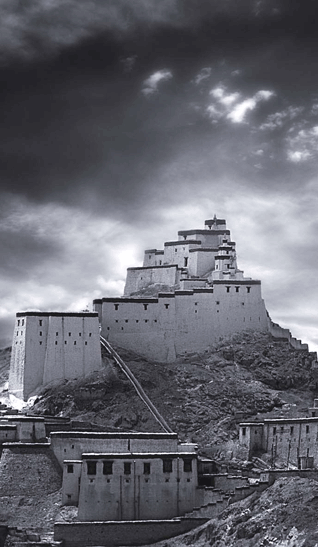Travel
Sikhs in Tibet
1904
AMARDEEP SINGH
Close to the Gyantse Fort in Tibet, at the Palkhor Chode Monastery, an old Chinese man approached me with curiosity. I reciprocated with a smile, which helped break the ice.
Old Chinese Man : “You are wearing a turban. Are you a Sikh?”
Me: “Indeed. I am surprised you are able to recognize a Sikh in this remote part of the world.”
Old Chinese Man: “Sikhs are no strangers to this region. In the past they have led many military expeditions at these formidable heights, with reasonable success.”
Me: “Yes, indeed. Around 1841, under the leadership of Maharajah Ranjit Singh of Punjab … I am aware that General Zorawar Singh’s forces came deep into Western Tibet. He fell at Taklakot where there still exists a Chorten (Samadhi / Grave memorial).”
Old Chinese Man : “You do know that era of the history. Well, the Sikhs entered again in 1904.”
1904 … the year has stuck with me since then. I had only heard about General Zorawar Singh’s successful expedition to Tibet in 1841 but what was his reference to the entry in 1904?
I thank the unknown old Chinese man for having created the spark of curiosity through a momentary encounter. I have since read the following three very old books to gain a better insight into Lietunant Younghusband’s expedition to Tibet in 1904 with the 23 and 32 Sikh Pioneer Regiments.
1 “With Mounted Infantry in Tibet”, by Major Ottley
2 “India and Tibet”, by Sir Francis Younghusband
3 “Waziristan to Tibet”, by Cyril Lucas
In the early 1900′s, the “Great Game” being played in Asia had resulted in the expansion of the British under the banner of The East India Company.
In the North of Asia, the Czars of Russia were becoming ambitious and expanding their reach into the Pamir mountain ranges, close to Afghanistan. British secret services were getting an indication of an alliance being forged between the Tibetans and the Russians. Should Russian reach extend into the Himalayan plateau, it would be too dangerous for British India.
Lietunant Colonel Sir Francis Edward Younghusband, with regiments of 23 Sikh Pioneers and 32 Sikh Pioneers, entered Tibet from Sikkim.
They were successful in conquering the Gyantse Fort (which was built around the 12th century) and made it their base from where they led further successful expeditions to Karo La pass (5,010 meter). These may sound just names but having traveled to these heights, due to thinness of air, I was finding it hard to even carry two camera bodies with long lenses. So one can only imagine what it would have meant to be a soldier at these heights.
The success of this expedition resulted in a treaty between British India and Tibet, resulting in weakening the Russian aspiration of expansion under the “Great Game”. British Indian forces subsequently moved back from the Tibetan plateau.
Along the way from Lhasa to Gyantse, one can still find the remains of small stone fortifications built by the 23 and 32 Sikh Pioneer Regiments to help defend from any attack on the outer posts.
History quotes Hannibal’s crossing of the Alps, in 218 BC, to invade imperial Rome as one of the most celebrated achievement of any military force in the ancient warfare. The Alps are pygmies in comparison to the advances that had to be made from the plains of India to Tibetan plateau, crossing the formidable Himalayas.
In the months to follow, I will also share my photography journey, tracing the footsteps of General Zorawar Singh. But for now, let me share the pictures and very old sketches pertaining to the 1904 expedition.
To view the full exhibit, please CLICK here.
March 23, 2013
Conversation about this article
1: Sunny Grewal (Abbotsford, British Columbia, Canada), March 23, 2013, 5:05 PM.
I am incredibly jealous of the author! It has always been my dream to take a historical trip in the footsteps of Sikh warriors!
2: Ari Singh (Sofia, Bulgaria), March 24, 2013, 8:02 AM.
Indeed yet another exciting article. I will give Hannibal credit for beiing so original and adventurous. Amardeep ji,your chance encounter with a local has opened a new chapter in Sikh heroism in a remote and impossible terrain. How many other locations are there which are unknown to us, where Sikh blood has been shed in the service of humanity! It's a pity that the British Empire was not fairly shared by the British and Sikhs.
3: Baldev Singh (Bradford, United Kingdom), March 24, 2013, 10:37 AM.
Was lucky enough to visit Zanskar, 'Little Tibet', one of the three provinces of Kashmir next to Ladakh, which was cut off from the outside world for 900 years until 1974! I hitched a lift with a busload of French tourists who were visiting a Buddhist temple or Gompa on top of a hill and when we entered this ancient edifice, the monks made a beeline for me. Smiling, one of the senior monks said to me in broken Hindi: 'Sardar ji, mai Ambarsar Darbar ho ke jaa-iaah tha!' Indeed, Guru Nanak connects so many of us.
4: Sarvjit Singh (Millis, Massachusetts, USA), April 30, 2013, 4:05 PM.
Wonderful to hear about Sikhs in Tibet. Was Zorawar Singh a Sikh or merely leading Ranjit Singh's Army as his General? Reason I ask is that the Dogras consider him as a Rajput Raja, not a Khalsa. The Shiv Sena in Jammu has his posters all over their offices.



